I ended up doing 12 rides for 380 miles in the month of June. That’s the most miles I’ve had in a month since last September, but the month ended the same way last month did, with me in the hospital and off the bike for days. It was pneumonia this time, found after I had a fever of 101.7 Saturday night. I’ll rest a few days then go back to riding.
100 miles this week
I took off on the F5 this morning and rode out to Big Rock Road, for 40 miles. That gives me 100 miles this week. For many years, I averaged 100+ miles a week, but between severe COVID in October, a heart attack in February, heart valve replacement in April, and a car crash in May, this was the first time in eight months that I’ve gotten 100 miles in a week. It felt good.
I’m still slow on the bike, but I’m seeing progress in improving. Today was the first time since I got back on the bike that I managed to do the entire ride without using the small chainring. It was also the first time I’ve averaged over 14 mph for the ride. I don’t know how close I’ll get to the level I was at last year, but I’ll take what improvements I can get.
I ended up with a total of 240 miles ridden in May. I had managed a couple of 80 mile weeks in a row, but a May 22nd car crash kept me off the bike for the rest of the month.
Back on the bike
I took off on the F5 this morning and rode out to FM2938 and back for a 20 mile ride. It was my first time on a bike since Marth 10th, and my first outdoor ride since October. I had taken time off the bike after my heart attack and didn’t ride again until February 20th. By early March my aortic heart valve had gotten really bad, plus my heart doctors were advising against riding until after it was replaced, so I quit riding after March 10th, until today. I ended up with just 65 miles ridden in February and 82 miles in March.
I am now eight days past aortic heart valve replacement. Today’s ride made it obvious that my fitness level is completely shot. Nothing to do but go to work on that.
Declining Health
After a promising recovery from COVID most of December, I had a serious setback near the end of the month, and the decline of my health continued and intensified in January and February. I did three rides totaling 70 miles that first full week of January, then managed only 40 miles the next week. My breathing worsened to the point I could only do 1500 on the spirometer, and I didn’t ride at all the next week. I had a slight improvement and did a couple of 15 mile rides that last week of January, but after that last ride, it was obvious that I couldn’t continue, so I stopped riding again. I ended up with 160 miles for the month.
My body wasn’t lying when it told me to stop. On February 4th, I had a heart attack. It wasn’t a major heart attack. The blockage was in an obtuse marginal artery, and a single stent fixed it. But the cardiac surgeon discovered, and an echocardiogram the next day confirmed, that I have severe aortic stenosis. The cardiac doctor said I need an aortic valve replacement right away. I had been diagnosed with moderate aortic stenosis three and a half years ago, and had no clue it had become this severe. I was, after all, still averaging 100 miles a week on the bike in October, before I got COVID.
The degree of aortic stenosis is measured by the pressure difference between the two sides of the valve. 25 to 40 is moderate. Anything over 40 is severe. Mine is 65. 80 is critical, so I’m closer to critical than moderate. Severe aortic stenosis can cause fluid buildup in the lungs, so it may be contributing to my lung issues. I won’t know how much until I get that valve replaced. Strenuous exercise is a big NO with severe aortic stenosis, so I’m going to remain limited in what I can do until I get that valve replacement. I didn’t even have a cardiac doctor, so now I’m waiting for a referral from the VA for a cardiac doctor, who will then refer me to to the specialist who will do the valve replacement.
While all this was going on, the VA has put me on some new inhalers, and they seem to be slowly helping. With all the dire weather stuff here, I hadn’t even checked my lungs with the spirometer lately, and was surprised to find yesterday that I can once again do 2500 on it. That’s a big improvement. I still have a lot of wheezing. I’m hoping that may improve soon too. I decided that with my improved lung function, I should try riding again, so today, I did a 10 mile ride on the Xstream. I kept things at a very easy pace, keeping my heart rate under 130. That’s probably as much effort as I should be putting out until I get my valve replacement.
I’m exhausted now. After just a 10 mile ride. It’s a pretty safe bet that I’ll never get back to the state of fitness I was enjoying last October. All I can do is be as active as my present health will allow, then see what I can do after recovering from valve replacement. I’m looking at a long road to recovery ahead.
2020 Miles
2020 has mercifully come to an end. I ended up with 4,492 miles ridden for the year. It was the first year since 2004 that I rode less than 5,000 miles (I started riding in September, 2004). Until mid October, I was on a pace to get the usual 5,200 miles that I’ve ridden annually in recent years, but COVID19 had other plans. 1,305 of those miles were trainer virtual miles, with the remainder being actual on the road miles.
My recovery had been going fairly well, and I rode 80 miles the third week of December, but I had a major setback on December 24th. I inhaled a pill. In all my years on earth, I’d never done that before. It was a magnesium supplement tablet. I put it in my mouth and took a drink of water, thinking I’d swallowed it. But I hadn’t. When I took a breath of air, it sucked the tablet into my left lung. That day ended up being the worst day of coughing of my life. The next day, I was sore all over from so much coughing. I hacked up grit the entire day. And, I became short of breath and got a terrible wheeze. When I tried to ride the next day, I gave up after 10 miles, then took four days off the bike.
By this week, I noticed my shortness of breath was getting better. I’m stil wheezing, but it’s not as bad as it was. So I did 20 mile rides on Wednesday, Thursday, and today. I still haven’t gotten back to where I was before I inhaled that pill, but I’m improving. Here’s to hoping for a better 2021.
Still recovering
I did weekly updates on my recovery from COVID19 on Facebook, and I probably should have done them here too, so here they are:
Nov 13
10 miles on the bike this morning. It was my seventh consecutive day of riding. Reviewing the stats from the week’s rides confirmed what I already knew: I got slower each day. Either I’m getting worse, or am doing more than my body can recover from. I have downloaded a home pulmonary rehab exercise video. I’m going to use it, instead of riding, for now. We’ll see how I do.
Nov17
It’s now been two weeks since I was released from the hospital. I’ve had no gain in lung function at all so far. I’m getting used to slow walking. If I stand up and walk at my normal pace, I’m out of breath by the time I get across the room. But after three weeks, my sinuses have almost quit bleeding, so I guess that’s progress. Baby steps….
Nov 22
Tuesday will mark three weeks since I got out of the hospital, and I’m finally seeing the first hint of lung function improvement. For those of you who’ve never used one, an incentive spirometer is for measuring the volume of air you can breathe into your lungs. From the beginning of my hospital stay, I’d only been able to hit 1500 ml on the spirometer. On my bad days, I could only do 1200. The last couple of days, I’ve been hitting 2000. That’s still a pretty pathetic reading for someone my size, but it’s a gain, the start of what I hope will be a lot more gains.
Dec 1
Today marks four weeks since I was released from the hospital. I’m doing 2250 on the spirometer now. Looking at the chart, that’s not much below normal for someone my age and height. But I still have shortness of breath, so it’s obviously not just a volume thing. It’s likely a lung tissue damage thing, too. I’m going to keep on patiently working to get stronger. I’ve started riding again, doing ten miles on the bike yesterday. I just picked a nice flat route on Rouvy. I don’t think I could pedal myself up much of a hill right now, either on a real road or on Rouvy. I had been doing my pulmonary rehab exercises pretty much every day (though I did take off the two days I went fishing last week), but I’ll probably just do them on the days I don’t ride now.
I was semi-retired when I got sick, still working a few hours most weeks. I’d like to get back to work, but I don’t think I’m ready just yet. Maybe in a week or two.
Dec 8
Today makes five weeks since I got out of the hospital. I am now doing 2500 ml on the spirometer. By the chart, that’s normal for someone my age and height, but I can tell I would have been doing more than that before I got sick. I rode the bike 10 miles last Monday, 15 miles on Wednesday, and 16 miles on Friday. Saturday night, I went out and danced my arse off. I even managed to do every line dance without getting too out of breath. So, while I’m nowhere near my peak cycling fitness level, I do seem to at least be functional now. I think I’m going to go back to work next week.
And those were my Facebook updates. It’s now December 19th. I ended up not working this week. The only job I had scheduled postponed until after New Year’s. I’ll turn 70 in April, so I guess if I end up just retiring, that wouldn’t be the worst thing that could happen. I have stopped doing the pulmonary rehab exercises and am now just riding and doing my core exercises. It seemed like I was no longer gaining anything from pulmonary rehab.
I’m doing 20 mile rides now. I’ve ramped up my distance and effort slowly. Severe cases of COVID19 have caused heart damage very often, and that was scary to me, especially since the most frequent damage is diastolic dysfunction, and I had already been diagnosed with moderate diastolic dysfuntion. But I haven’t seen any evidence of new heart damage in my case yet. Up until this week, I limited my heart rate to under 140 on my rides, and I’m still limiting it to under 150.
Truth be told, that’s really not any different than my normal winter riding. I always ease up effort and distance in the winter. I treat it like a recovery period, and start ramping up my effort again in the spring. And I ended up with over a 16 mph average on the bike on two of my rides this week. That’s very good for me, even on a flat route, when I’m only putting out an easy to moderate effort, even in past years. That’s very encouraging. It means that, for easy to moderate winter efforts, I’m getting the same results I have for years. Of course, if I really put out a high intensity effort, either on or off the bike, I have really bad shortness of breath in short order, a reminder that I’m not nearly fully recovered. But, I’ll take encouraging news where I find it.
In past years, I’ve tried to hit peak fitness in August, in time for the Hotter ‘N Hell Hundred. But I’ll turn 70 before the next one. If you’re past 70, should you still be on the road mixing it up with 10,000+ other cyclists in a 100 mile event? I’m not sure I’m ready to answer that one. And that’s ignoring the fact that I don’t know if I’ll ever even be fit enough to complete another 100 mile bike ride. But, I’ll worry about all that at a later date. Right now, I’m reasonably pleased with my progress. I rode 80 miles this week. I was pretty tired the last half of today’s 20 miles, but just being able to ride 80 miles in a week shows a real improvement in my endurance, which hasn’t been good at all since I got sick. I’ll keep working on that.
Lake Benbrook – November 13th
My fossil hunting came to a screeching halt in mid October when I got COVID. My lung damage didn’t do me any favors apparently, and it really hit me hard. I was in ICU for eight days, and still have disabling shortness of breath a week and a half after getting out of the hospital.
But I’ve been itching to get out, so I decided to make a trip to Lake Benbrook. I figured I wouldn’t have to walk far from where I parked, so could manage some hunting. It was still too much for me, as it turned out. What should have been a five minute hike back up the hill to the van took me twenty minutes, as I had to keep stopping to catch my breath. I’m hoping my pulmonary rehab will improve things, but it’s looking like it may take a while.
Macrostrat showed Fort Worth Limestone and Duck Creek Formation, undivided where I was, but Kiamichi Formation was nearby too. I knew I wasn’t up to any major chiseling, so just took photos of anything big I ran across. Here are some photos I took. I really liked how those oysters and bivalve stood out in that lower left photo. Click the photos to be able to zoom in and get a closer look.
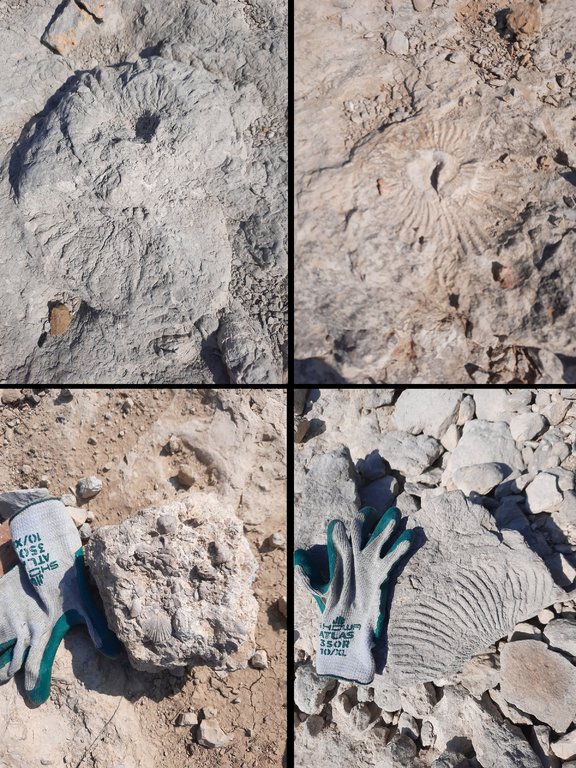
Other than one tooth, I was just finding oysters, bivalves, and an occasional piece of an ammonite, but I thought these looked a lot like fish fins. After investigating, they appear to be pinna bivalves. I left them in place.
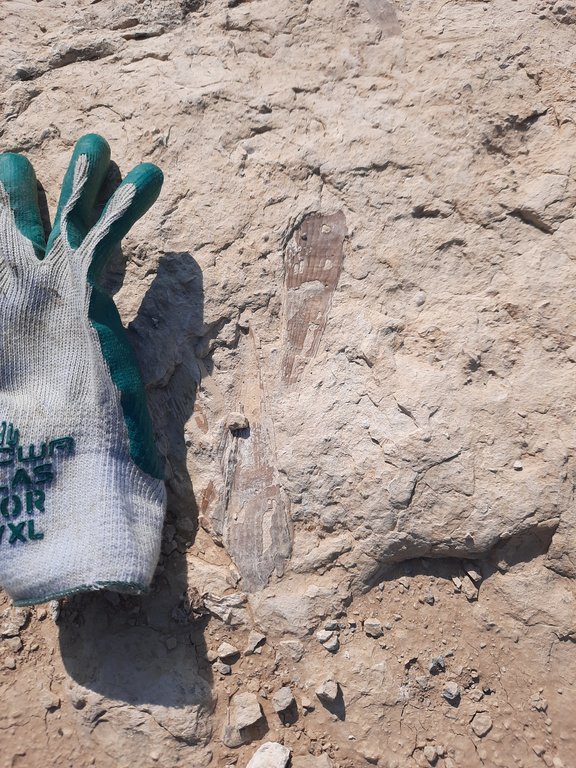
Here is what I brought home. That tooth is very different from any I’ve found before, and I had no idea what it was, but from all the online searching I did, I believe it’s a Paraisurus tooth. Always fun finding something new and different.
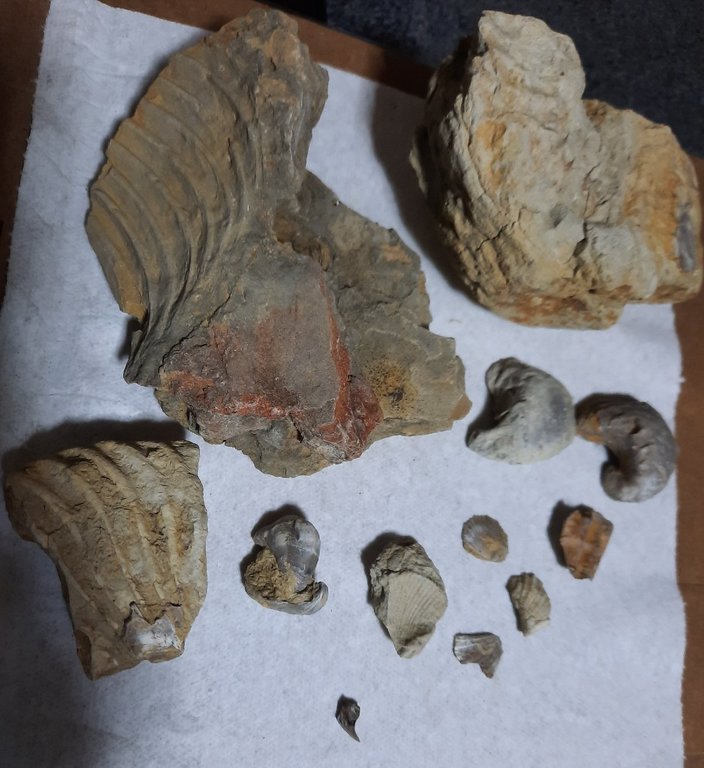
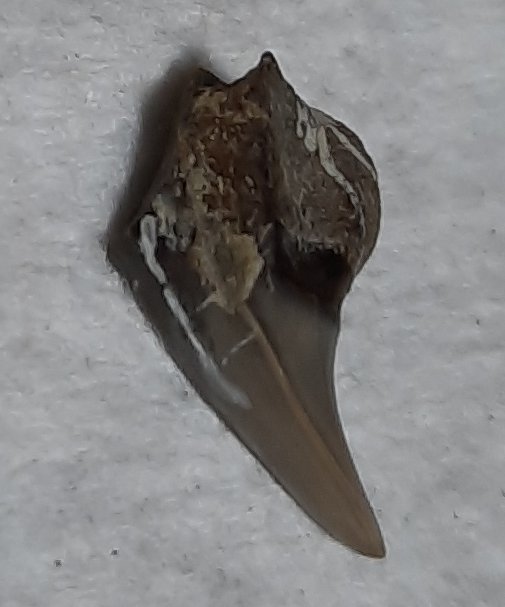
I’m getting forgetful in my old age. I forgot to include a scale to show the size of the tooth. What is so unusual about it is that the flat side is oriented perpendicular to the root, rather than parallel with it, like all the other shark teeth I’ve found. And there is no second flat side. The rest of the tooth is all a curve. The only way I could think of to show the flat side in a photo was to use a small piece of paper towel to prop it up, like I’ve done in the photo on the right.
This tooth only has half the root. From what I’ve read, the root of these teeth preserves very poorly, and they are most often found with no root at all. That makes me want to look through all the teeth I have. It’s possible that I’ve found one or two of these before, but did not recognize it because of the missing root. It’s the orientation of that root that makes them recognizable. That, plus only having one flat side.
Edit: Looking through my teeth, I was reminded that there are quite a few with one flat side, and rounded the rest of the way around. But I have nothing else with the root oriented like this one.
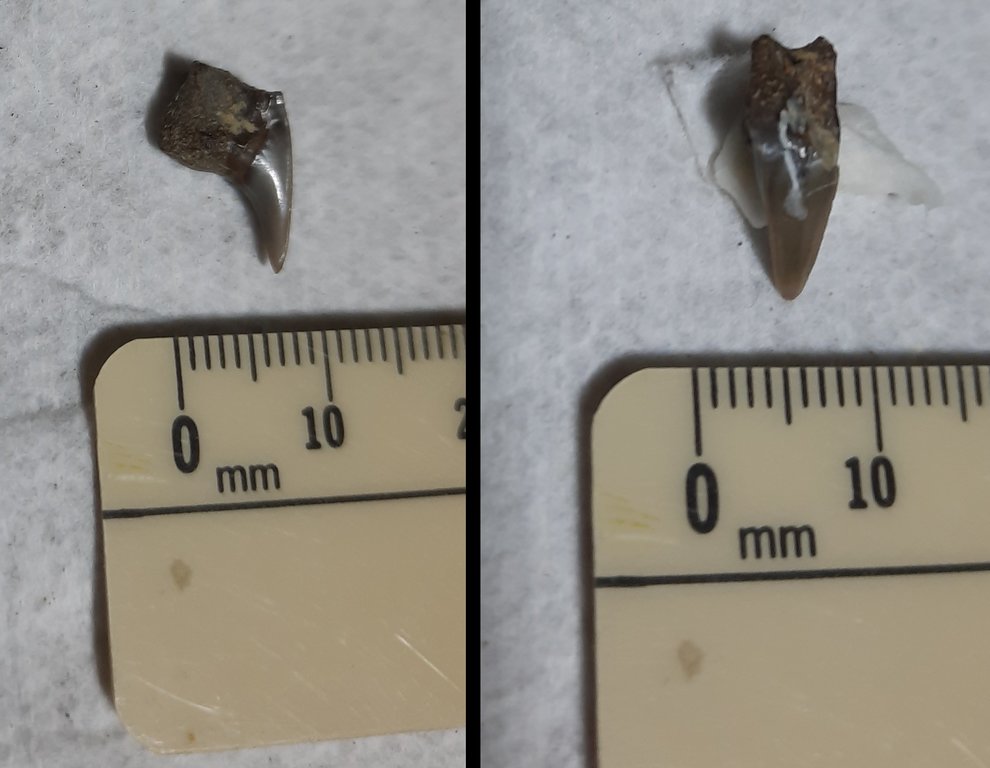
Crashed and burned with COVID
With no Hotter ‘N Hell Hundred to get ready for this summer, I just rode shorter routes, and my mileage wasn’t all that great. I managed 440 miles in August and 491 miles in September. Little did I know what was waiting for me in October.
The first half of the month saw me ride 200 miles. My last ride was on the 16th, a Friday morning where I took off intending to ride 30 miles, but a howling wind, combined with the fact that I didn’t feel very well, made me cut the route off and just do 20 miles. That night, I got sick, and the next day was diagnosed with COVID.
If you are a lung cancer survivor, getting by on 1.5 damaged lungs, there’s a greater than zero chance that COVID will hit you very hard, and it did me. I fought it at home for a week, then admitted myself to the Dallas VA Medical Center. Just two days into my stay there, my oxygen levels crashed, and I spent the next eight days in ICU. I got out of the hospital the day before yesterday, and it’s obvious I have a long road to recovery in front of me. I weigh 170 pounds. I haven’t been that light in almost 50 years. There seems to be skin hanging off of bone everywhere I look.
And just standing up gets me out of breath. Just walking across the house was almost more than I could accomplish that first day home. I did a short walk yesterday, and a quarter mile walk or so today. I’m thinking I’ll try getting on the bike tomorrow. It’s a safe bet that any rides I do right now are going to have to be pretty short and slow. I can’t think of a better lung function rehab though, so we’ll see how I do.
Hill County creek – October 6th
I decided to take a break in picking through the matrix from my last trip and actually get out and hunt this morning. I drove over to Hill County, and tried out a new creek. I really didn’t find anything worth mentioning there, left and stopped on the way home at the creek where I’d found so much mud three weeks ago. It was much drier this time, and I had a lot easier time navigating it. But I still didn’t find many fossils. Just like last time though, it produced one that made the trip really worthwhile. This is a fish tail, possibly a Xiphactinus. Click the photos to be able to zoom in and get a closer look.
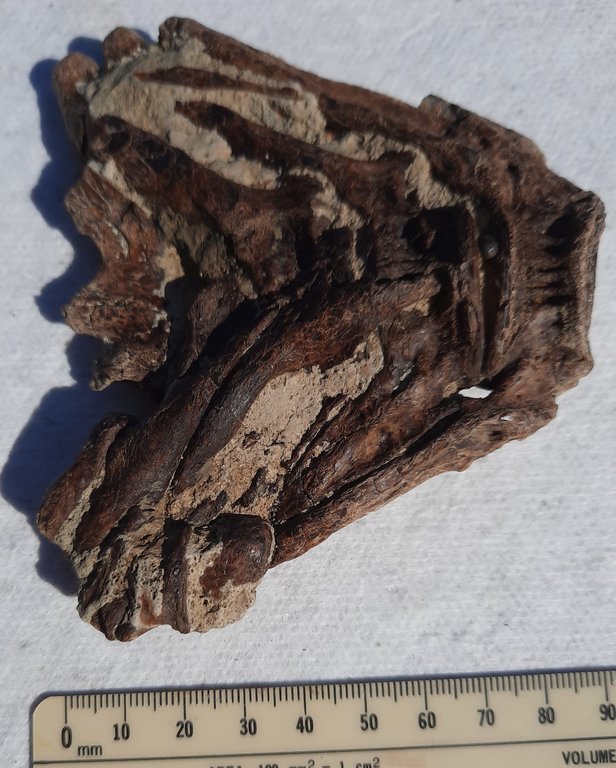
Here’s the other side. It’s a very different fossil than anything else I’ve found. I am really taken with this one.

Ellis County creek – September 30th
I made a quick trip yesterday back to the Ellis County creek where I found so many teeth. With all the work being done to deer stands and feeders near it last time I was there, I knew my days of being able to hunt it this year were numbered, and sure enough, I have been officially banned by the landowner whose pasture I must cross to get to the creek, until at least next February.
I knew my two best micro-spots in the creek were pretty much played out until we get floods and erosion, but I figured I might spend some time searching the gravel bars in the creek, and walk a little further down the creek than I had before. I made the walk further down the creek first, and never got around to searching the gravel bars very much. Here’s what I spotted just past where I’d been before. How many teeth can you see in that matrix? Click the photos to be able to zoom in and get a closer look.
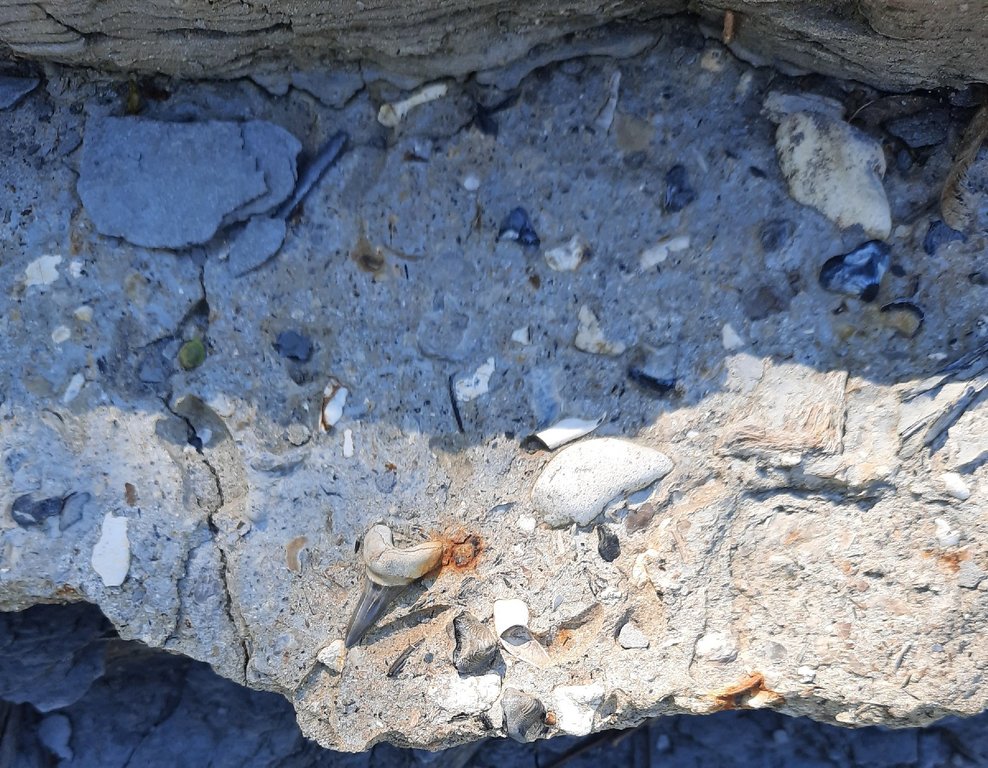
Besides that one, I brought home some other great looking pieces of matrix. Here are just a few of them.

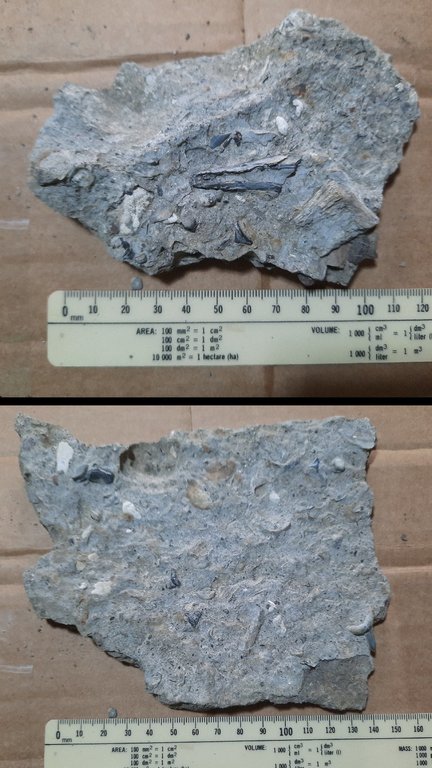
Obviously, I have a lot of matrix work waiting for me, and I’ll post photos showing what comes out of the matrix later, but I wanted to post photos of a couple of other pieces now. Here is the find of the day, a pliosaur tooth. It’s crumbling too badly for me to remove it from that matrix, but I still thought it was a great find.

And this vert. Even with a piece broken off, it’s still the prettiest vert I’ve ever found. From everything I’ve looked at, it seems to most favor a Coniasaurus vert.
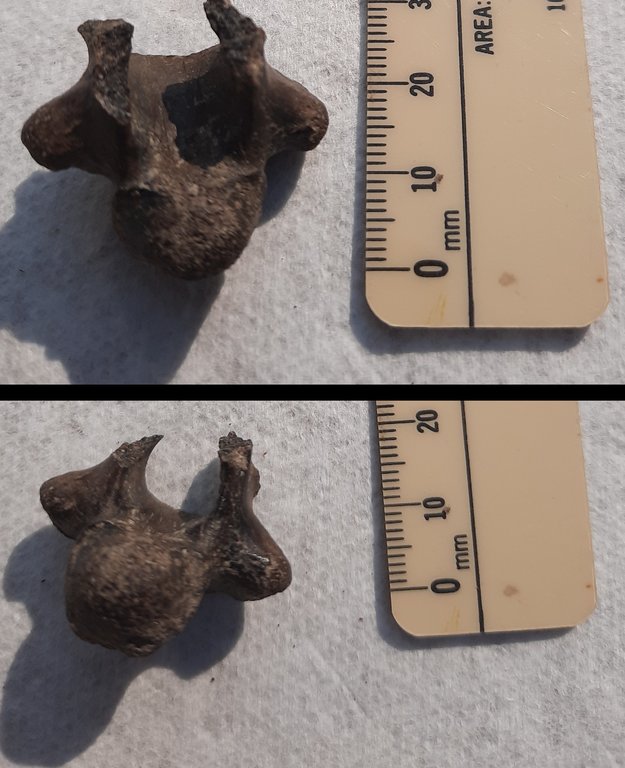
Update: October 3rd. I have stabilized the pliosaur tooth, and think it’s going to hold together.
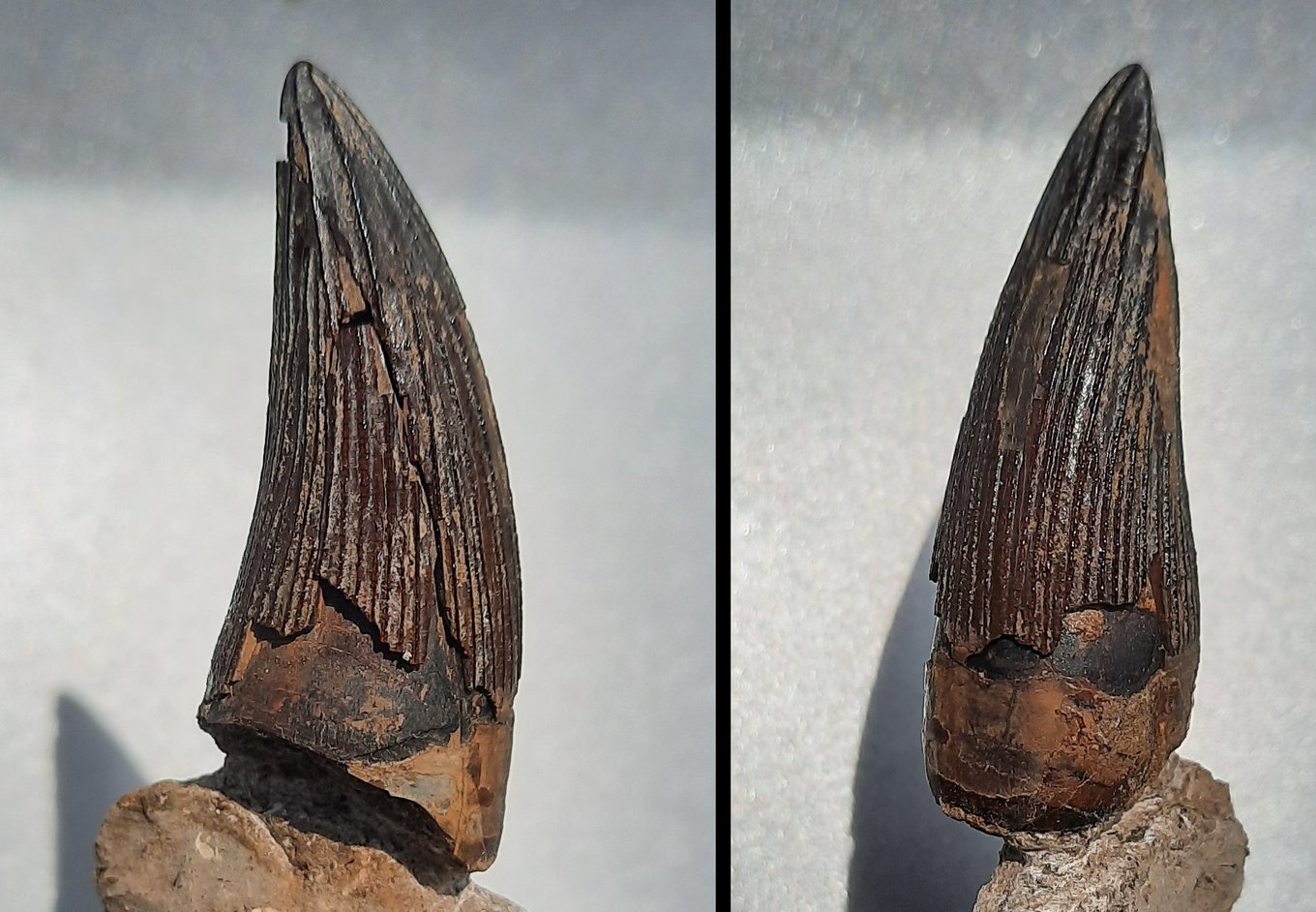
Update: October 9th. I have finally finished going through the matrix from this trip. Here are the Ptychodus teeth, all 97 of them.
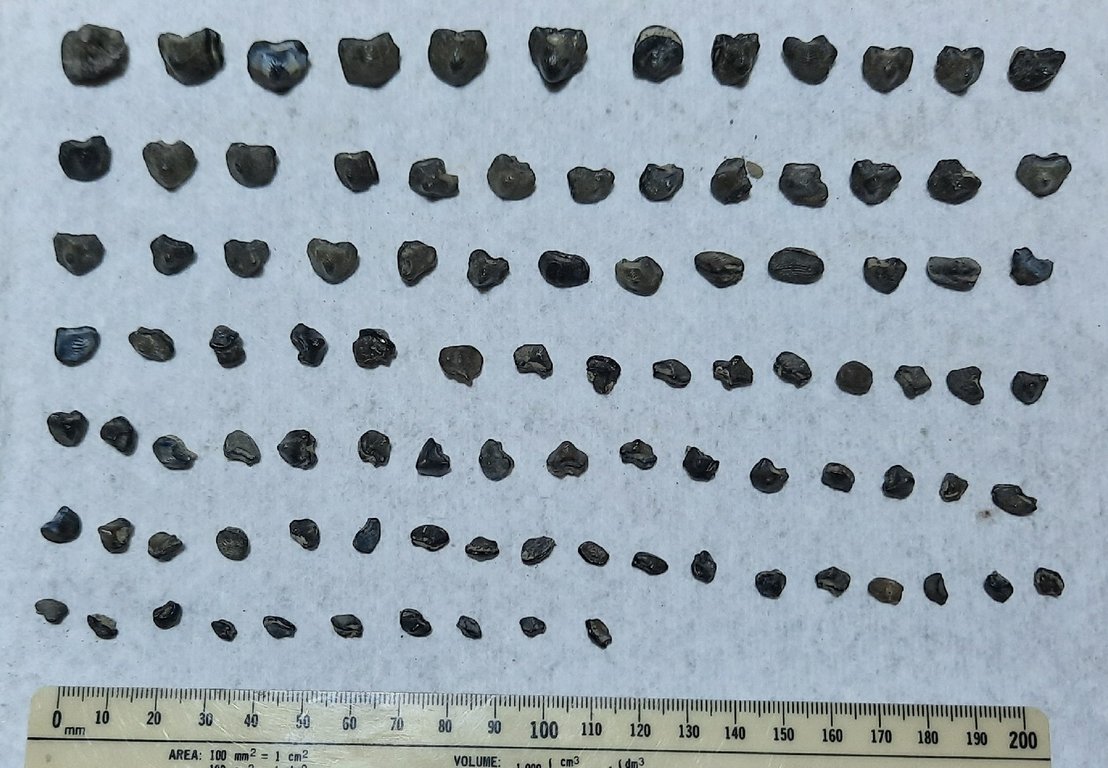
And the other teeth. There were 93 of them. Since I forgot to include the scale in the photo of all of them, the photo below shows the four largest with the scale.
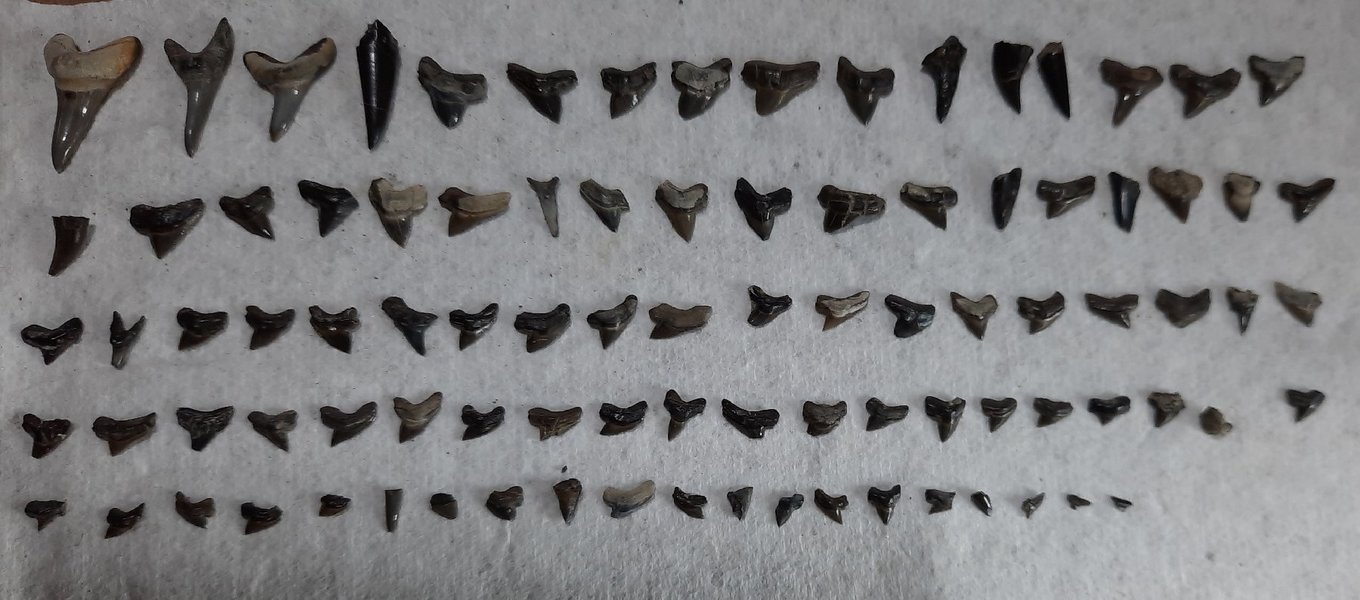

And finally, the Pliosaur tooth is delicate enough that I decided it needed a protective display. Here is what I came up with.






